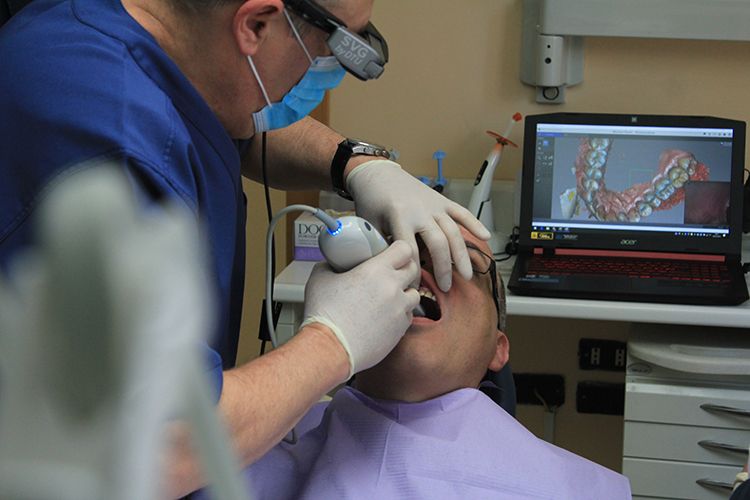IOS Scanners
Intraoral scanners (IOS) are taking the dental industry by storm.
No longer do you need rubber bowls and flexible spatulas to mix up that gooey alginate. With intraoral scanners, you can take digital impressions of the patient’s mouth that cause less patient discomfort, are time-efficient, result in impressions that are far more accurate, and allow synchronous case discussions with the dental technician.
Impressions made with digital technology eliminate problems faced when dealing with patients who have strong gag reflexes and small mouths, both adults and children. The need for impression trays in multiple sizes, chemical and powdered impression materials that are bulky and time sensitive, and the time commitment for taking conventional impressions is outdated.
By using digital intraoral scanning impression technology, you no longer have to schedule time for gathering and mixing materials, holding trays in the patient’s mouth, pouring the plaster, waiting for the plaster to set, and writing up the lab orders.
With IOS technology, you send digital files of your patient’s impression to the lab electronically, eliminating the need to wait for the courier to make his or her rounds. Then, the dental lab with the proper digital setup easily imports the impression files.
Related: How to Send Your Digital Scans to First Choice Dental Lab
Save Time & Reduce Costs
As with all innovative technology, there is a learning curve when first using IOS.
But, once you become comfortable with your scanner, even your most complex cases will be simplified.
Is the first scan attempt less than perfect? No problem! Just recapture another scan without the nightmare of taking another conventional impression.
And, what about that messy lab area with all that plaster dust and hardened residue on the counter tops and sinks? Gone forever in offices that adopt the IOS systems.
Take a look at your monthly costs for stone, plaster, alginate, polysulfides, silicones, and impression trays. Utilizing an intraoral scanner greatly reduces those expenses.
Now, consider the time spent by you and your staff to take and process impressions – from the first step until the lab picks up the box. With IOS, you’ll only need to complete a form and click send!
Think of the productivity your practice will have when you eliminate those wasted minutes and hours.
Improved Communication With Your Dental Lab
Let’s now consider communication with your trusted lab technician.
Case Study: Fully Digital Workflow for a Full Mouth Rehab
Using conventional impression techniques, you wait for a few hours (or even days) for the case to reach the lab. Then, you call the tech to discuss the case: a case you no longer can hold in your hand as you discuss the patient’s needs since the only plaster cast is at the lab, not in your office.
IOS technology allows you and your dental lab technician to discuss each case in real time, before the patient even leaves the chair. Should the technician see potential problems, you can make any needed adjustments, and take a new scan immediately.
Hence, there’s no need to bring your patient back in for another impression! Better communication with both the lab and with the patient makes everyone happy.
Better Patient Experiences
Speaking of communication with your patients, offices that have implemented IOS technology find that their patients feel more involved in their own treatment.
They see the images of their teeth, and get a better idea of what to expect as their case progresses. That process will become one of your best marketing tools, as satisfied and emotionally engaged patients tend to spread the word to their friends and family.
Potential Drawbacks of IOS
Drawbacks to IOS do, of course, exist in most practices.
A learning curve exists, as previously mentioned, but once a clinician has mastered the technology, the advantages become clear and compelling.
IOS systems have difficulty detecting subgingival margins, especially in the presence of bleeding. However, with proper tissue management procedures in place, that issue is easy to resolve. Additionally, many doctors utilize lasers to get clearer looks at subgingival margins.
Of course, the biggest drawbacks are initial cost and ongoing upgrades. As with all hard equipment investments, the long-term gains in productivity eventually offset the short-term pains.
Final Say For IOS
Accuracy, efficiency, patient comfort, better communication with the technicians and patients, and simplification of impression procedures make IOS the ideal technology for the busy dental practice.
From iTero and 3shape to 3M and Carestream, top IOS producers introduce more and more IOS systems each year.
Related Article: Intraoral Scanning Becoming Dentistry Standard
Here at First Choice Dental Lab, we’ve worked with every type of intraoral scanner, and we can help you choose the best one for your practice.
Contact us today by completing the form below, or by calling us at 1-866-791-7025, and let our experienced technicians help you make the decision that’s right for you!



